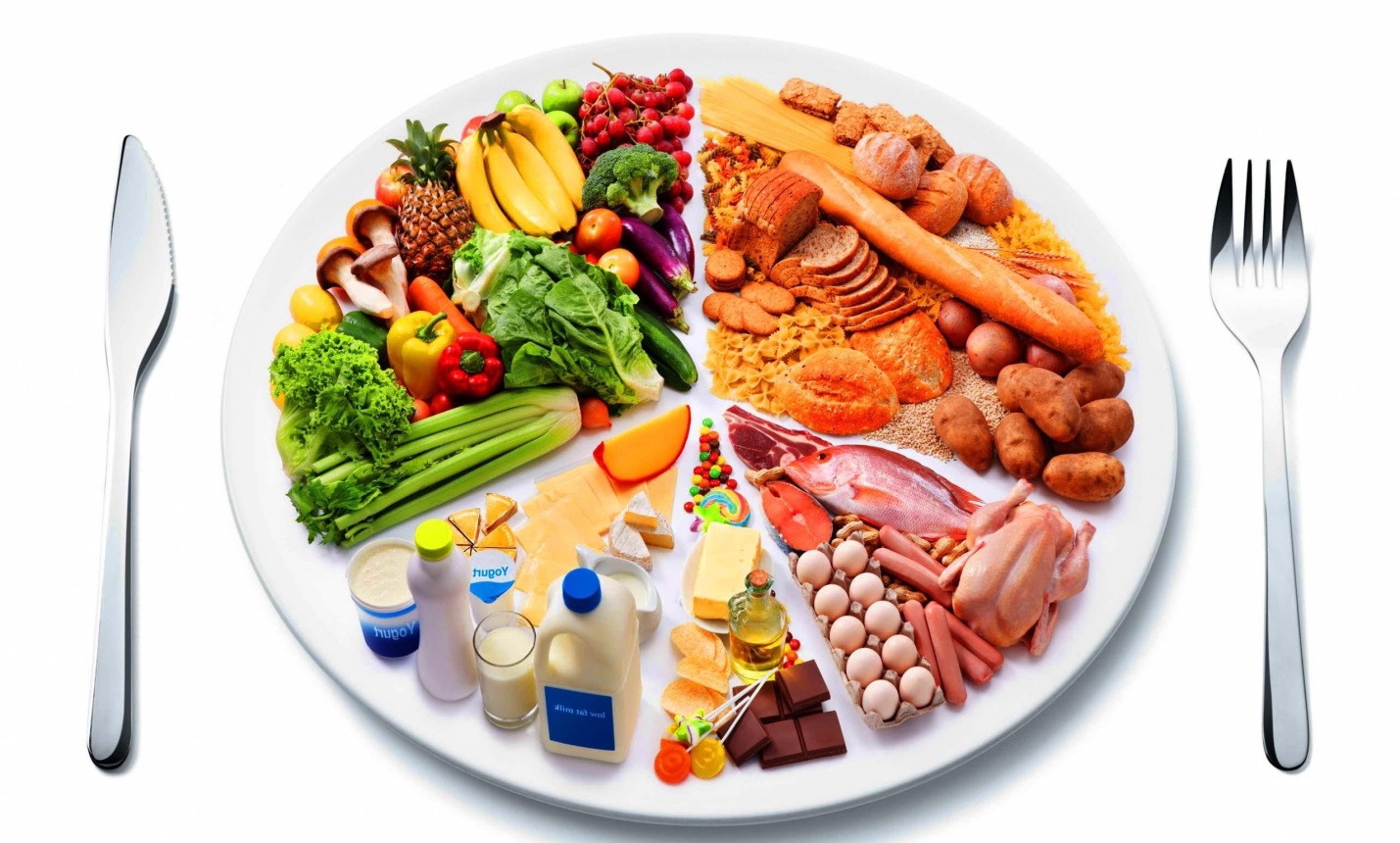Nutrition Know How
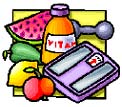
What you eat has a life long effect on your health and well-being. To look and feel your best, you have to eat adequate amounts of the proper foods. Many teenagers don’t always choose the food that is best for them. They may not want to eat what the rest of the family is eating or they may eat poorly at school. The food at the school cafeteria is required by law in the United States to meet certain nutritional standards, but you may not be eating their food.Nutrition… Nutrition… Nutrition… Adults are always talking about good nutrition and eating the right foods. Isn’t it enough to eat the things that we enjoy eating? Not necessarily, unless you like eating foods rich in vitamins, minerals and other essential nutrients. Sounds boring? It doesn’t have to be. If you are going to eat well you have to take some of the initiative and responsibility for what you eat. You’ll be doing your family a big favor as well as learning how to take care of yourself.
Nutrients build your body and allow it to function. Each nutrient has at least one specific job, and no other nutrient can cover for any of the others. Because you need many different nutrients to stay healthy, you have to eat a wide variety of foods in order to get all of them. If you stick to just one or two favorite foods, you’ll run short of the nutrients you must have to stay well.
A lot of the foods that we like to eat don’t have much nutritional value. These foods are referred to as “junk food” = empty calories, because while they provide calories that can be turned into energy, they don’t provide much else in the way of things our bodies can use.
There are six types of nutrients: protein, carbohydrates, fats, vitamins, minerals, and water. In simple terms, nutrients are the chemicals that your body gets from food. If your body gets the right fuel, just like a car, it will run smoother. Nutrients in food allow your body to break down the food you eat into energy so can use function. When you go for a run, swim a few laps, or even talk on the phone you are using energy that your body has produced. When you are taking a test, you’re using brain power, which is really energy that is coming from the food you had last night for dinner and this morning for breakfast. One nutrition key is to never skip breakfast, especially the morning of tests. Your body has not received energy for more than 12 – 15 hours and will not be able to function at its peak without that boost you get from food.
A Closer Look At The Nutrients Our Bodies Need
Vitamins and Minerals
These nutrients don’t supply your body with energy because they don’t have calories. However, they are necessary because they help your body convert food into energy. Using our car analogy, vitamins and minerals are like spark plugs in a car, not the gas. The thirteen vitamins: A, C, D, E, K and the eight B vitamins (thiamine, riboflavin, niacin, B6, pantothenic acid, biotin, folacin, and B12) can be divided into two types: fat-soluble and water-soluble. You do not need to consume the fat-soluble vitamins everyday in order to maintain their proper levels because they are stored in your body fat and liver. But, the water-soluble vitamins, the B-complex vitamins and C, dissolve in the water in your system. So, these vitamins should be consumed everyday (with the exception of B12, which your liver stores).
| Vitamin A | Promotes normal bone growth, healthy skin, hair and eyes, helps with night vision. |  |
| Vitamin C | Strengthens blood vessels, helps the immune system, heals wounds and helps heal broken bones. |  |
| Vitamin D | Helps absorb calcium for strong bones and teeth, your body produces this from sunlight. |  |
| Vitamin E | Ensures that Vitamins A and C are not destroyed by oxygen and are properly used by your body. Helps form red blood cells. |  |
| Vitamin K | Called the clotting-factor vitamin, it enables your liver to produce a blood-clotting factor to control and prevent internal bleeding. |  |
| Vitamin B-Complex (8 different vitamins and minerals) |
Breaks down carbohydrates and fat to energy, works to give you a healthy nervous system and healthy skin, helps you digest food and utilize minerals in foods you eat, important in the production of red blood cells, and works with proteins to build and repair tissues. |  |
| Thiamine | Helps keep your nervous system healthy, breaks down (Vit. B1) carbohydrates into energy. |  |
| Riboflavin | Breaks down carbs, proteins and fats so your body can use (Vit. B2) them for energy and repair. |  |
| Niacin | Works with riboflavin to convert proteins into energy. (Vit B3) |  |
| Calcium | Needed for healthy bone and teeth development, helps with muscle function, helps blood to clot. |  |
| Iron | Ensures the body produces red blood cells — which transport oxygen. (Needed to produce hemoglobin – the red oxygen carrying pigment in blood.) |  |
| Folic Acid | Needed to produce genetic material (DNA & RNA), needed during and before pregnancy to prevent birth defects. |  |
Protein
 Every single cell in your body is made up of protein. Hair and fingernails consist of fibers of protein called keratin. Collagen is the protein that strengthens your skin, blood vessels, bones and teeth. Even your muscles are held together by the protein fibers called myosin and actin. In fact, about one-fifth of your body weight is protein. Every chemical reaction that takes place in your body — that is a lot — is dependent on proteins. These important nutrients help us build new cells and repair damaged body tissue. Because your tissues are constantly being destroyed and rebuilt, and because unlike carbohydrates your body has no means to store protein, you must make sure you get enough of this important nutrient to keep all your vital processes functioning. During digestion, large molecules of protein are broken down into smaller, simpler units called amino acids. The body requires 22 amino acids in specific patterns to make human protein and thus do its necessary functions. Your body can produce all but nine of these amino acids. The nine that can not be produced are called essential amino acids because they must be supplied by your diet. In order for your body to properly use proteins, all of the essential amino acids must be present in your system. A food that contains all the essential amino acids is called a complete protein. Examples of foods high in protein include: meats, fish, lentils, nuts, dairy products such as cheese or yogurt and beans.
Every single cell in your body is made up of protein. Hair and fingernails consist of fibers of protein called keratin. Collagen is the protein that strengthens your skin, blood vessels, bones and teeth. Even your muscles are held together by the protein fibers called myosin and actin. In fact, about one-fifth of your body weight is protein. Every chemical reaction that takes place in your body — that is a lot — is dependent on proteins. These important nutrients help us build new cells and repair damaged body tissue. Because your tissues are constantly being destroyed and rebuilt, and because unlike carbohydrates your body has no means to store protein, you must make sure you get enough of this important nutrient to keep all your vital processes functioning. During digestion, large molecules of protein are broken down into smaller, simpler units called amino acids. The body requires 22 amino acids in specific patterns to make human protein and thus do its necessary functions. Your body can produce all but nine of these amino acids. The nine that can not be produced are called essential amino acids because they must be supplied by your diet. In order for your body to properly use proteins, all of the essential amino acids must be present in your system. A food that contains all the essential amino acids is called a complete protein. Examples of foods high in protein include: meats, fish, lentils, nuts, dairy products such as cheese or yogurt and beans.
Carbohydrates
 Most of our energy comes from carbohydrates. Carbohydrates are chemical compounds of carbon, hydrogen and oxygen. They provide us with calories which can be converted into energy. There are two types of carbohydrates: simple, which are sugars, or complex, which are starches. It’s a good idea to try to eat more complex carbohydrates because your body get longer sustained energy from these foods. Examples of complex carbohydrates include: potatoes, pasta, bread, rice, lentils, cereals and fruits and vegetables. Compare these to the simple carbohydrates such as cookies, candy bars and other sugar foods which provide a quick jolt of energy, but then leave your body craving more. These simple carbohydrates are known as “empty calories” because they lack vitamins, minerals, fiber or anything of value to your system.
Most of our energy comes from carbohydrates. Carbohydrates are chemical compounds of carbon, hydrogen and oxygen. They provide us with calories which can be converted into energy. There are two types of carbohydrates: simple, which are sugars, or complex, which are starches. It’s a good idea to try to eat more complex carbohydrates because your body get longer sustained energy from these foods. Examples of complex carbohydrates include: potatoes, pasta, bread, rice, lentils, cereals and fruits and vegetables. Compare these to the simple carbohydrates such as cookies, candy bars and other sugar foods which provide a quick jolt of energy, but then leave your body craving more. These simple carbohydrates are known as “empty calories” because they lack vitamins, minerals, fiber or anything of value to your system.
Fats
 While too much fat is bad for your health, we do need some to survive. By cutting down on your fat intake you can reduce your chances of developing heart disease or cancer, not to mention staying in better physical shape and maintaining a healthy weight. There are three types of fat: saturated, monounsaturated and polyunsaturated. Saturated fats are the worst type because they raise the cholesterol level in your blood, which can lead to heart disease. The more saturated the fat is, the more solid it will appear at room temperature. This includes animal products such as butter, cheese, milk and meats. Monounsaturated fats are the types in nuts and fruit and polyunsaturated fats are found in oils. If you are trying to reduce the fat content in your diet, try broiling rather than frying your food, use skim milk rather than whole milk, use low-fat salad dressing or yogurt, and cut down on red meats.
While too much fat is bad for your health, we do need some to survive. By cutting down on your fat intake you can reduce your chances of developing heart disease or cancer, not to mention staying in better physical shape and maintaining a healthy weight. There are three types of fat: saturated, monounsaturated and polyunsaturated. Saturated fats are the worst type because they raise the cholesterol level in your blood, which can lead to heart disease. The more saturated the fat is, the more solid it will appear at room temperature. This includes animal products such as butter, cheese, milk and meats. Monounsaturated fats are the types in nuts and fruit and polyunsaturated fats are found in oils. If you are trying to reduce the fat content in your diet, try broiling rather than frying your food, use skim milk rather than whole milk, use low-fat salad dressing or yogurt, and cut down on red meats.
Fiber
 Okay, you are right, there is no nutritional value in fiber. But we do know that fiber absorbs water, helping both keeping away hunger pangs and to keep the colon healthy by allowing bowel movements to be regular, softer and easier to pass. Fiber has an important role in protecting us from certain diseases, such as heart disease, high blood cholesterol, some cancers and bowel conditions. It also can keep us leaner (people who eat a lot of fiber are less likely to be overweight). Fiber is present in the cell walls of all plants, but is NOT found in any food obtained from animals. It can be found in all foods of plant origin like fruits, vegetables and nuts. It is also found in unrefined breads, cereals, brown rice, corn kernels and beans. Cellulose and pectin, found in all stringy vegetables and apples (and other fruit) cannot be digested, but they are important as roughage.
Okay, you are right, there is no nutritional value in fiber. But we do know that fiber absorbs water, helping both keeping away hunger pangs and to keep the colon healthy by allowing bowel movements to be regular, softer and easier to pass. Fiber has an important role in protecting us from certain diseases, such as heart disease, high blood cholesterol, some cancers and bowel conditions. It also can keep us leaner (people who eat a lot of fiber are less likely to be overweight). Fiber is present in the cell walls of all plants, but is NOT found in any food obtained from animals. It can be found in all foods of plant origin like fruits, vegetables and nuts. It is also found in unrefined breads, cereals, brown rice, corn kernels and beans. Cellulose and pectin, found in all stringy vegetables and apples (and other fruit) cannot be digested, but they are important as roughage.
Water
 Our bodies are about two-thirds water, and we need to ensure that we keep up this balance in order to remain healthy. That’s why it is recommended that you drink at least eight glasses of water every day. This will keep all your organs hydrated so that they can function properly, and water also helps to flush toxins and other impurities out of your body. Water serves many other crucial functions including: respiration, digestion, metabolism, body temperature regulation and excretion. Water is also responsible for dissolving and transporting nutrients through the body. Only oxygen is more important to sustaining human life than water. So, drink a tall glass of water and stay healthy!
Our bodies are about two-thirds water, and we need to ensure that we keep up this balance in order to remain healthy. That’s why it is recommended that you drink at least eight glasses of water every day. This will keep all your organs hydrated so that they can function properly, and water also helps to flush toxins and other impurities out of your body. Water serves many other crucial functions including: respiration, digestion, metabolism, body temperature regulation and excretion. Water is also responsible for dissolving and transporting nutrients through the body. Only oxygen is more important to sustaining human life than water. So, drink a tall glass of water and stay healthy!
Pyramid Power
The main components of healthy eating habits include food from the six basic food groups. And, if you cover your bases, you probably don’t need to take supplemental vitamins. You can get all the nutrients your body requires just by eating right. In fact, it is best for your body to absorb vitamins and minerals directly from food rather than from a little pill. Each vitamin, mineral or nutrient you absorb has a very particular job to perform. See the vitamin & mineral chart to find out what job each of these vitamins and minerals does to ensure a healthy body.
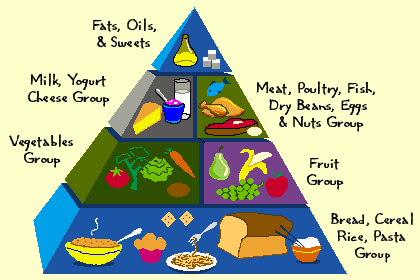
There is nothing mysterious about the Food Pyramid. You have probably seen it in school and on food packages. It actually is simple but important information; it doesn’t require any memorization or complicated math. All you have to remember is eat lots from the bottom, less from the middle, and a little from the top. That is it. It is not necessary to eat the exact number of servings from each group every day. Instead, your intake should average out to the portions indicated over a period of one to two weeks. See, isn’t that easier than you thought.
Calories
The energy in food is called calories. Everyone talks about them as if they are the last things you would want to put into your body. But the truth is, you need them. You need them because your body is always using energy, whether you’re running, walking, standing still, or sleeping. Cut back on calories too much, and your system will slow down. Lay off them altogether, and you will die. More people in the world die from too few calories than from too many.
Calories…
- supply energy for growth
- provide energy so that your heart, lungs, brain, and other organs can operate to keep you alive
- give you energy for being physically active
- give you energy for thinking
If Calories Are So Great, Why Is Everyone So Paranoid About Them?
Because it is so easy to get too many of them, and extra calories turn into fat. You can put on fat if you take in more calories than your body can use. To avoid adding extra fat, you have to eat as many calories as you need, and no more. Some people manage this by figuring out how many calories they use in the day, memorizing the amount in various foods, then adding up as they chew and swallow. This is a bit extreme! We don’t recommend you do this. Counting calories can make mealtime more tedious than any math class. Unless your health care provider has put you on a special weight loss diet, you don’t have to bring your calculator to the dinner table. Just having a general idea about how much calories are in the foods you eat should be enough to help you keep excess calories from becoming excess fat.
A Calorie Is A Calorie Is A Calorie
 An important point to remember is that all calories are the same. The calories in a piece of chocolate cake are no more fattening than the calories in a strawberry. The cake is more fattening than the strawberry because it contains more calories, not a different kind of calories. In other words, foods vary greatly in the number of calories they give you, so it’s not only the amount you eat that matters, but the number of calories in the food you choose to eat. You could, for example, eat one piece of chocolate cake and end up consuming many more calories than you would get from eating several baskets of plain, fresh strawberries. That chocolate cake is looking pretty good to me right now actually. Yum!
An important point to remember is that all calories are the same. The calories in a piece of chocolate cake are no more fattening than the calories in a strawberry. The cake is more fattening than the strawberry because it contains more calories, not a different kind of calories. In other words, foods vary greatly in the number of calories they give you, so it’s not only the amount you eat that matters, but the number of calories in the food you choose to eat. You could, for example, eat one piece of chocolate cake and end up consuming many more calories than you would get from eating several baskets of plain, fresh strawberries. That chocolate cake is looking pretty good to me right now actually. Yum!
There are a lot of overweight people who complain that they get fat even though they don’t eat very much. This is often true. Very often they’re not eating big meals, but the foods they DO eat at those meals are very high in calories.
Remember…
- Growing bodies need more calories than grown ones. That’s one reason why you shouldn’t put yourself on a low-calorie diet right now, without checking with your health care provider. If you just start hacking away at the calories in your diet, chances are good that you’ll disturbed your body’s growth in some way.
- Busy bodies need more calories than inactive ones. When you’re active you spend energy that could be helping you grow. You have to make up for it by eating more.
- Large bodies need more energy than small ones do. The more body you have, the more energy it takes to keep it going.
How can you tell how many calories are in the foods you eat? The easiest way to tell how many calories are in a particular food is to read the nutrition information label on the package it comes in. This tells you how many calories are in one serving. You can use the nutrition information labels to compare the number of calories in different brands and types of foods.
Carbohydrates
 Unless you are on some wacky and dangerous diet, you should eat more carbohydrates than anything else because more foods are carbohydrates than anything else. Potatoes, pasta, bread, rice, fruits of all kinds, honey, and sugar, are all carbohydrates. What makes carbohydrates alike, obviously, it’s not the way they taste, but the fact that they are made of sugar. Sugar takes on different forms, so that the sugar in a potato or in a piece of spaghetti tastes different from the sugar you would find in a candy bar or in a can of soda. The different forms of sugar not only have different flavors, but more important, have different effects on your body.
Unless you are on some wacky and dangerous diet, you should eat more carbohydrates than anything else because more foods are carbohydrates than anything else. Potatoes, pasta, bread, rice, fruits of all kinds, honey, and sugar, are all carbohydrates. What makes carbohydrates alike, obviously, it’s not the way they taste, but the fact that they are made of sugar. Sugar takes on different forms, so that the sugar in a potato or in a piece of spaghetti tastes different from the sugar you would find in a candy bar or in a can of soda. The different forms of sugar not only have different flavors, but more important, have different effects on your body.
Carbohydrates have gotten a really bad rap from people who think they are fattening. The truth is that most carbohydrates contain no fat at all. Plain potatoes, rice, pasta, and many types of bread are fat-free. The fat comes along with the butter, cream, and cheese that you add to them.
Carbohydrates…
- Give you energy. Of all the nutrients, carbohydrates are the best source of energy. It takes a while for the energy from protein and fat to get into your system. Your body can use the energy from carbohydrates right away.
- Carbohydrates contain lots of in vitamins.
- Contain fiber. As we said before fiber is the rough stuff in food that keeps your digestive system “regular”. In other words, it helps you have regular bowel movements.
Not all carbohydrates provide these benefits. Plain sugar, honey, corn syrup, and molasses don’t add anything to your diet but yummy flavor and calories. In fact, they actually make you hungrier and weaker than before you ate them. Here’s what happens:
- You are hungry.
- You eat a candy bar.
- You’re not hungry anymore, because the sugar from the candy is immediately released in your blood, which carries the energy from the sugar to your brain. When your brain is receiving energy, you don’t feel hungry.
- Now your body reacts. It can’t handle that much sugar. It produces a substance called insulin to clear the sugar out of your blood.
- The insulin does what is supposed to do and more. It gets rid of the sugar from your candy, plus whatever sugar was left in your body from an earlier meal. Now there is no sugar left to provide energy for your body and your brain. What happens? You feel hungry again. And then the cycle begins all over.
If you are going to have lasting energy, you have to eat foods that are released slowly. Carbohydrates have less obvious sugar (carbohydrates don’t taste sweet really) and give you the kind of energy that lasts. So bread, crackers, and unsweetened cereals make better snacks than candy, cookies, or ice cream. The best carbohydrates are fresh fruits, vegetables, whole grain breads, cereals, crackers, and pasta. They carry lots of vitamins and fiber and they release sugar slowly, providing energy that lasts a long time.
From Your Plate, Not a Pill
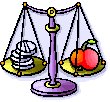 Sure you can buy vitamins and minerals in bottles, but the best source of them is from the foods you eat. Since different foods have different vitamins, the best way to make sure you’re covered is to eat a variety of foods everyday. Here is another time when “Pyramid Power” comes in handy. Remember, lots from the bottom, less from the middle, and a little from the top. This should ensure a healthy diet that will keep you full of energy and healthy. If your life is very, very hectic, a vitamin supplement can help make up for what you may be lacking in your fast-paced life. There are other times too when a vitamin supplement is necessary, like when you are healing from surgery or a wound. So, vitamins from a bottle are important at times and for many medical conditions. Learn how to calculate your
Sure you can buy vitamins and minerals in bottles, but the best source of them is from the foods you eat. Since different foods have different vitamins, the best way to make sure you’re covered is to eat a variety of foods everyday. Here is another time when “Pyramid Power” comes in handy. Remember, lots from the bottom, less from the middle, and a little from the top. This should ensure a healthy diet that will keep you full of energy and healthy. If your life is very, very hectic, a vitamin supplement can help make up for what you may be lacking in your fast-paced life. There are other times too when a vitamin supplement is necessary, like when you are healing from surgery or a wound. So, vitamins from a bottle are important at times and for many medical conditions. Learn how to calculate your
BMI and find out what it means.
Visit the Food Table, from a Registered
Dietitian. See what you’re doing right or wrong.
Watch informative videos on nutrition and related topics! Here’s one on “Fat Facts“. Or how about “Nutrition For Brain Health” or check out Brain Food – Can you Eat Yourself Smart? And Foods to Help Prevent Osteoporosis
Recommended Reading:
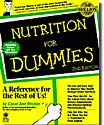 Nutrition for Dummies by Carol Ann Rinzler Nutrition for Dummies by Carol Ann Rinzler
The completely updated second edition separates the fluff from the fiber with 30 percent new material on the the latest nutritional data and advice. Charts, tables & line drawings. |
 The Carbohydrate Addict’s Carbohydrate Counter by Rachael F. Heller; Richard Ferdinand Heller The Carbohydrate Addict’s Carbohydrate Counter by Rachael F. Heller; Richard Ferdinand Heller
People who want quick information to help them follow the Hellers’ popular carbohydrate addicts program can get easy carbohydrate counts through this at-a-glance book. Easy-to-read, alphabetized bar graphs show which foods are lowest in carbohydrates. High-low comparison charts list carbohydrates in descending order, so readers can make fast choices. |
Back to Nutrition I
Back to Top
